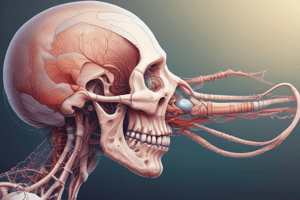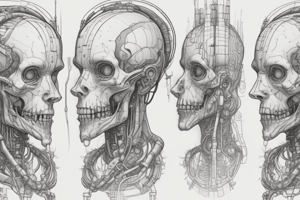Podcast
Questions and Answers
What is the main driver for Gastrulation and formation of a Trilaminar Embryo?
What is the main driver for Gastrulation and formation of a Trilaminar Embryo?
Cell movement
What are the main germ layers formed during Gastrulation?
What are the main germ layers formed during Gastrulation?
- Endoderm
- Mesoderm
- Ectoderm
- All of the above (correct)
Gastrulation converts pluripotent cells to multipotent cells.
Gastrulation converts pluripotent cells to multipotent cells.
True (A)
Primitive streak gives rise to the __________ layer.
Primitive streak gives rise to the __________ layer.
Match the following components with their roles in embryo development:
Match the following components with their roles in embryo development:
Where do the heart and great vessels originate from during the embryonic development?
Where do the heart and great vessels originate from during the embryonic development?
What contributes to the formation of the pericardial coelom?
What contributes to the formation of the pericardial coelom?
The paired, endothelial-lined endocardial heart tubes fuse to form a primordial heart tube.
The paired, endothelial-lined endocardial heart tubes fuse to form a primordial heart tube.
The functional cardiovascular system is established by day 26, with 3 branches: the Arterial System sends impure blood back into the ________ Artery.
The functional cardiovascular system is established by day 26, with 3 branches: the Arterial System sends impure blood back into the ________ Artery.
Match the following embryonic development events with their descriptions:
Match the following embryonic development events with their descriptions:
Study Notes
3rd Week of Human Development
- Objectives:
- Understand how cell movement drives Gastrulation and the formation of a Trilaminar Embryo (3-Germ Layers)
- Learn about the formation of the Primitive Streak and Notochord
- Learn about the beginning of Neurulation
- Understand the formation of the Neural Plate, Neural Tube, Neural Crest, and the Brain
Formation of the Trilaminar Embryo
- Gastrulation: conversion of a bilaminar to a trilaminar embryonic disc consisting of endoderm, mesoderm, and ectoderm
- Gastrulation begins with the formation of the primitive streak
- During Gastrulation, the embryo is individualized, and twins cannot form
Emergence of the Primitive Streak
- The primitive streak elongates medially from the thickened dorsal epiblast surface of the bilaminar embryo
- The bilaminar embryonic disc converts to a trilaminar embryonic disc as the primitive streak gives rise to the mesoderm layer
- The epiblast is now called the ectoderm layer, and the hypoblast is replaced by the endoderm layer
- Axial orientation is established, giving bilateral symmetry to the embryo
Formation of the Notochord
- The primitive streak degenerates and shortens, but adds cells to elongate the notochordal process under the epiblast
- The notochordal process induces the overlying embryonic ectoderm to form the neural plate, which gives rise to the CNS
- On Day 21, the notochordal process flanked by neural folds also begins to fold, forming a tube called the notochord
Neurulation
- The neural plate invaginates along its central axis to form a neural groove flanked by neural folds
- The neural folds fuse to form the neural tube, which delaminates from the ectoderm
- The neural tube forms the primordium of the brain vesicles, spinal cord, and retina
Neural Crest, Spinal Ganglia, and the Epidermis
- The neural fold is flanked by neural crest cells
- The neural crest cells migrate ventro-laterally and form the spinal ganglia
- The surface ectoderm becomes delaminated and fuses to form a continuous epidermis layer
Somite Formation Defines the Axial Skeleton
- Paraxial mesoderm forms between the neuroectoderm and endoderm, adjacent to the notochord
- The paraxial mesoderm differentiates, condenses, and divides into somites in a cranio-caudal sequence
- By Day 35, there are 44 somites, forming the axial skeleton
Development of Intraembryonic Coelom
- Coelomic space fuse to form a horseshoe-shaped cavity, the intraembryonic coelom
- The lateral mesoderm splits into somatic mesoderm (parietal layer) and splanchnic mesoderm (visceral layer)
Early Development of the Cardiovascular System
- Day 16: Extraembryonic mesoderm forms blood islands that fuse to form blood vessels that attach to the connecting stalk
- Day 18: Intraembryonic mesoderm forms blood islands that fuse to form blood vessels that attach to the connecting stalk and chorion
- Cranially, intraembryonic mesoderm converts to cardiogenic mesoderm, forming the early cardiovascular system and a heart primordium
Vasculogenesis and Angiogenesis
- Vasculogenesis: vascular channels form by assembly of cells called angioblasts
- Angioblasts aggregate to form clusters of blood island, which form cavities that coalesce to form primordial blood vessels
- Angiogenesis: budding, sprouting, and branching of new vessels from pre-existing endothelial vessels
Primordial Cardiovascular System
- Day 20-21: Heart and great vessels originate from the cardiogenic mesoderm
- Lacunae in the lateral mesoderm contribute to the formation of the pericardial coelom
- Paired, endothelial-lined endocardial heart tubes fuse and form a primordial heart tube
Functional Cardiovascular System
- The heart tube joins with blood vessels in the embryo, connecting the stalk, chorion, and umbilical vesicle to form a functional cardiovascular system
- The system has three branches by Day 26: the arterial system, the umbilical vein, and the vascular plexus of vitelline veins
Summary of the 3rd Week
- Initiation of gastrulation, where the embryonic disc is converted from a bilaminar to a trilaminar disc
- Formation of the primitive streak, which gives rise to the mesoderm
- Formation of the notochordal process, which induces the formation of the neural plate
- Formation of the neural tube, which gives rise to the CNS
- Development of the intraembryonic coelom, somites, and the axial skeleton### Embryo Folding and Development
- 18-24 days: Cylindrical human embryo forms with lateral body folds
- Folding occurs in two directions: longitudinal (cephalo-caudal) and lateral (transverse)
- Longitudinal folding due to rapid enlargement of cranial end of neural tube and primordial brain
- Lateral folding due to rapid enlargement of somites, leading to wrapping of amnioblast around embryo and pinching of yolk sac
Hindgut Development and Germ Layer Derivatives
- Day 28: Lateral folding fuses three germ layers in the cylinder
- Endoderm in the center forms midgut and a primordium intestine
- Foregut and hindgut are already defined earlier
- Lateral folding reduces connection between midgut and yolk sac, forming an omphaloenteric duct
Morphological Changes in Early Week-4
- Day 22-23: Major morphological changes occur in the embryo
- Day 22: Embryo is straight with ~4-10 somites
- Day 23: Medially placed neural tube has 8-10 somites, open to amniotic cavity at cranial and caudal ends
Formation of Pharyngeal Arches and Heart Development
- Day 24: First pair of pharyngeal arches (mandibular arch) emerge, forming mandible and maxilla
- Heart starts pumping blood; rostral neuropore closes
Development in the Late Week-4 Embryo
- Day 26: Three pairs of pharyngeal arches emerge at 27-somite stage
- Rostral neuropore closes, forebrain enlarges, and embryo becomes C-shaped
- Lens placode, otic pit, and nasal placode develop
Emergence of Limb Buds and Chambered Heart
- Day 27: Upper limb buds develop as small swellings on ventrolateral body
- Day 28: Fourth pair of pharyngeal arches formed; lower limb buds emerge, caudal neuropore closes, and nasal placode prominently emerges
- Primordial organ systems form; large primordial heart defines atrium and ventricular prominences
Studying That Suits You
Use AI to generate personalized quizzes and flashcards to suit your learning preferences.
Description
This quiz covers the objectives of the 3rd week of human development, including cell movement in gastrulation, formation of the trilaminar embryo, and the development of the primitive streak and notochord.




